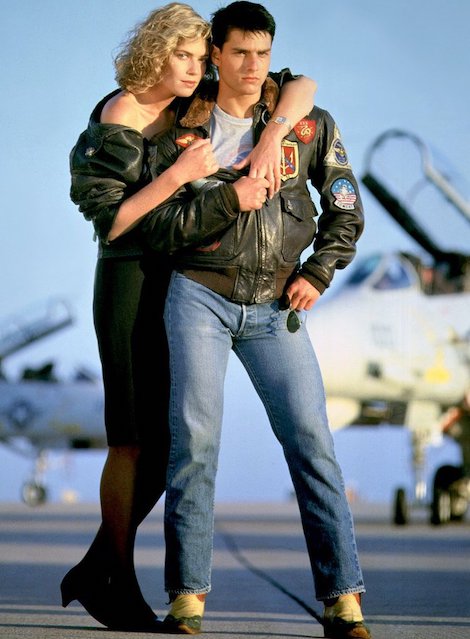Tuesday, May 20, 1986.
TOP GUN. Written by Jim Cash and Jack Epps, Jr. Music by Harold Faltermeyer. Directed by Tony Scott. Running time: 109 minutes. Mature entertainment with the B.C. Classifier’s warning: occasional coarse language and swearing.
IT'S A ZOO UP there. High above the Indian Ocean, naval aviators "Cougar" (John Stockwell), "Merlin" (Tim Robbins), "Maverick" (Tom Cruise) and "Goose" (Anthony Edwards) encounter a pair of Soviet “MiG 28s” (sic). *
* Note: According to the current [1986] Jane’s Aircraft there ain’t no such MiG mark, hence the (sic) in the previous paragraph. We just want the military equipment sophisticates among Province readers to know that we are not fooled by this film’s plot inventions.
For several tense minutes, the American F-14 Tomcats engage in a non-shooting dogfight with the Russian warbirds. The confrontation ends when the MiG pilots concede the bluffing match, break away and return to their base.
Among the American flyers, Lt. Pete Mitchell, call sign "Maverick," is the hero of the day. Back aboard the aircraft carrier Enterprise, he learns that he and his radar intercept officer, Lt. Nick Bradshaw, call sign "Goose," have been selected for the elite Naval Fighter Weapons School at N.A.S. Miramar, California's Fightertown, U.S.A.
According to an opening title card, the U.S. Navy sends "the top one per cent" of its pilots to Miramar to learn "the lost art of aerial combat." In each class, there is keen competition for the title Top Gun.
A blustering, bellicose remake of An Officer and a Gentleman (1982), director Tony Scott's smug service drama was inspired by an article in the May 1983 issue of California Magazine. In place of cocky Richard Gere, it offers Tom (Risky Business) Cruise as the flyer whose "fitness report says it all."
"He's a wild card," complains Major Dick "Jester" Heatherly (Michael Ironside). "He flies by the seat of his pants. He’s completely unpredictable.”
His brashness amuses civilian instructor Charlotte "Charlie" Blackwood (Kelly McGillis). She quickly warms to him, though, when she discovers that he's "the only pilot who's ever been up against a MiG-28."
Scott, the brother of Ridley (Legend) Scott, is a former director of TV commercials currently specializing in "designer" movies. Filmgoers who saw his debut feature, The Hunger (1983), will remember its chilly, high-style look and, perhaps, the lovingly photographed intimate encounter between actresses Catherine Deneuve and Susan Sarandon.
In Top Gun, Scott's affections are lavished upon the military hardware and the hard guys. Poor Ms McGillis, last seen as Harrison Ford's Amish love interest in 1985’s Witness, appears deliberately uglified for her role.
Not only are her features buried under a ton of pancake makeup, but Scott's merciless close-ups emphasize all of her worst angles. An actress who has been compared to Grace Kelly, McGillis's appearance here is more that of Emmett Kelly.
Made with the full co-operation of the U.S. Navy, Top Gun is simple-minded nonsense attempting to generate a few cheap thrills from a good-guy/bad-guy world view. Scott's TV-movie script and photographic style serve to underscore the emptiness of the entire exercise.
The above is a restored version of a Province review by Michael Walsh originally published in 1986. For additional information on this archived material, please visit my FAQ.
Afterword: Back in 2019, I posted my review of director Jim Abrahams’s service comedy Hot Shots! to mark the 100th anniversary of Remembrance Day. The 1991 feature was a satirical remake of Top Gun, and in my Afterword I said that Tony Scott’s picture “was a Pentagon-sponsored response to the various anti-war features that followed 1979’s Apocalypse Now into the movie marketplace.”
Although alt-right media pundits would have us believe that Hollywood is a nest of socialist subversion, the truth is that profit-conscious film producers are among America’s most conservative corporate executives. To help them toe the acceptable line, the U.S. Department of Defense has maintained an “entertainment liaison office” in Los Angeles since 1946. It can and does request script changes in exchange for advice and permission to use locations, personnel and equipment such as jet fighters and aircraft carriers.
For a brief period, things got out of hand. In the mid-1960s, a new generation of filmmakers were coming of age, and Baby Boomers were increasingly aware that the war in Vietnam was not going well. By the late 1970s, directors such as Robert (M*A*S*H) Altman, Oliver (Platoon) Stone, and Michael (The Deer Hunter) Cimino had turned the anti-war film into an award-winning subgenre. Eventually, the powers that be took note, and then took action.
Tony Scott, a man who’d made his mark directing stylish TV commercials, was perfect for the job. His DoD-sponsored Top Gun was the top-grossing film of 1986, and was credited with creating a major spike in U.S. Naval Aviation recruitment. More importantly, it wrested control of the narrative away from the peaceniks, restoring America’s men in uniform to starring roles in the popular culture.
In the above review, I included a mock footnote indicating that the screenwriters had made up the MiG aircraft bested by “Maverick" Mitchell in the film’s opening scenes. I probably should have pointed out that the aerial combat —dogfighting — skills celebrated on screen had been considered obsolete since the Second World War. Yes, there had been some inconsequential inflight duels during the Korean War — director Louis King’s 1953 feature Sabre Jet might have been the inspiration for Top Gun — and even a few over the skies of Vietnam. But in the real world, missile technology pretty much ended the era of fighter pilots engaging in knightly jousting in the heavens above. Apparently, they’ve yet to break the news to Tom Cruise.
